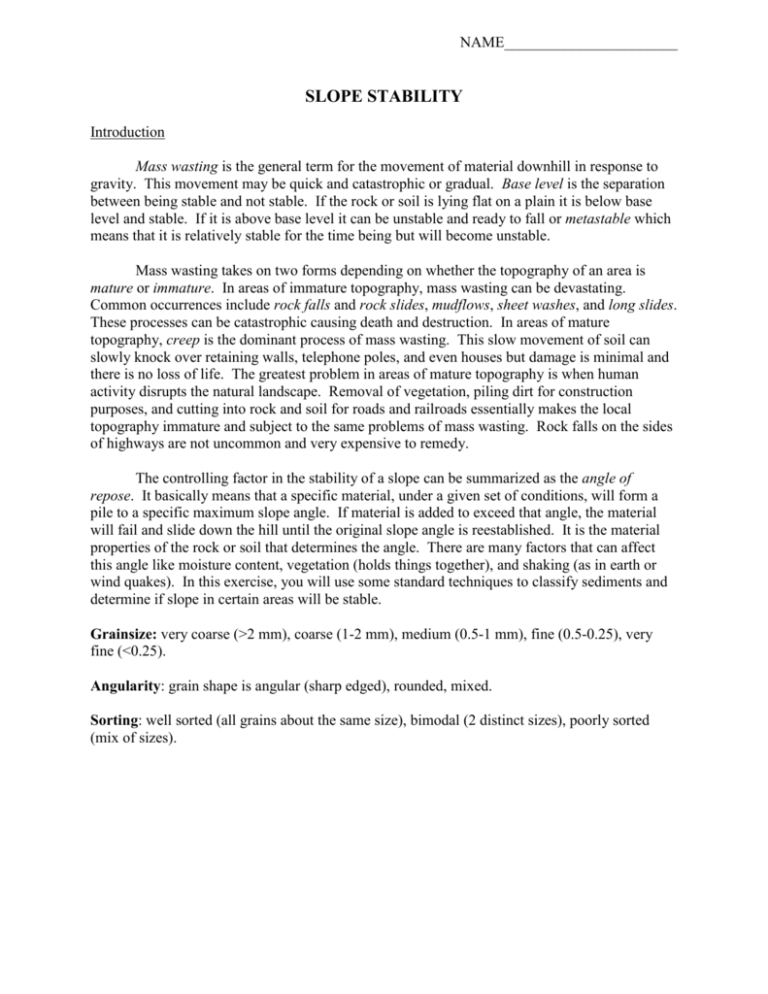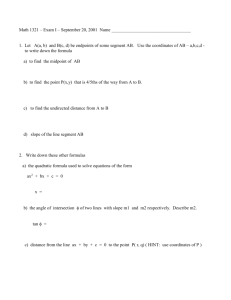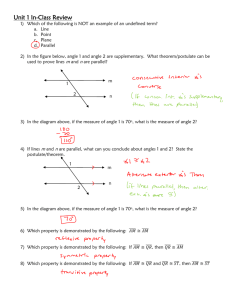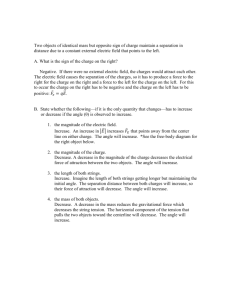Slope_Stability
advertisement

NAME_______________________ SLOPE STABILITY Introduction Mass wasting is the general term for the movement of material downhill in response to gravity. This movement may be quick and catastrophic or gradual. Base level is the separation between being stable and not stable. If the rock or soil is lying flat on a plain it is below base level and stable. If it is above base level it can be unstable and ready to fall or metastable which means that it is relatively stable for the time being but will become unstable. Mass wasting takes on two forms depending on whether the topography of an area is mature or immature. In areas of immature topography, mass wasting can be devastating. Common occurrences include rock falls and rock slides, mudflows, sheet washes, and long slides. These processes can be catastrophic causing death and destruction. In areas of mature topography, creep is the dominant process of mass wasting. This slow movement of soil can slowly knock over retaining walls, telephone poles, and even houses but damage is minimal and there is no loss of life. The greatest problem in areas of mature topography is when human activity disrupts the natural landscape. Removal of vegetation, piling dirt for construction purposes, and cutting into rock and soil for roads and railroads essentially makes the local topography immature and subject to the same problems of mass wasting. Rock falls on the sides of highways are not uncommon and very expensive to remedy. The controlling factor in the stability of a slope can be summarized as the angle of repose. It basically means that a specific material, under a given set of conditions, will form a pile to a specific maximum slope angle. If material is added to exceed that angle, the material will fail and slide down the hill until the original slope angle is reestablished. It is the material properties of the rock or soil that determines the angle. There are many factors that can affect this angle like moisture content, vegetation (holds things together), and shaking (as in earth or wind quakes). In this exercise, you will use some standard techniques to classify sediments and determine if slope in certain areas will be stable. Grainsize: very coarse (>2 mm), coarse (1-2 mm), medium (0.5-1 mm), fine (0.5-0.25), very fine (<0.25). Angularity: grain shape is angular (sharp edged), rounded, mixed. Sorting: well sorted (all grains about the same size), bimodal (2 distinct sizes), poorly sorted (mix of sizes). Procedure 1) Angle of repose Dump 1/2 of the sample of sediment provided onto a piece of paper and measure the angle of the slope relative to the table using a protractor. Repeat the exercise for the entire sample. Do the same thing for each sample. Look closely at the sample to classify it. Sample A) Describe the soil (color, grain size, sorting, angularity of grains)_________________ ______________________________________________________________________________ Angle for 1/2 ______________________________, 2/2 ________________________________ Now add enough water to your sample to moisten it and mix thoroughly. Repeat the procedure. Angle for 1/2 ______________________________, 2/2 ________________________________ Now add enough water to saturate the sample. Repeat the procedure. Angle for 1/2 ______________________________, 2/2 ______________________________ Sample B) Describe the soil (color, grain size, sorting, angularity of grains)_________________ ______________________________________________________________________________ Angle for 1/2 ______________________________, 2/2 ________________________________ Now add enough water to your sample to moisten it and mix thoroughly. Repeat the procedure. Angle for 1/2 ______________________________, 2/2 ________________________________ Now add enough water to saturate the sample. Repeat the procedure. Angle for 1/2 ______________________________, 2/2 ______________________________ Sample C) Describe the soil (color, grain size, sorting, angularity of grains)_________________ ______________________________________________________________________________ Angle for 1/2 ______________________________, 2/2 ________________________________ Now add enough water to your sample to moisten it and mix thoroughly. Repeat the procedure. Angle for 1/2 ______________________________, 2/2 ________________________________ Now add enough water to saturate the sample. Repeat the procedure. Angle for 1/2 ______________________________, 2/2 ______________________________ Sample D) Describe the soil (color, grain size, sorting, angularity of grains)_________________ ______________________________________________________________________________ Angle for 1/2 ______________________________, 2/2 ________________________________ Now add enough water to your sample to moisten it and mix thoroughly. Repeat the procedure. Angle for 1/2 ______________________________, 2/2 ________________________________ Now add enough water to saturate the sample. Repeat the procedure. Angle for 1/2 ______________________________, 2/2 ______________________________ 2) Application to a problem The attached topographic map is of an area in northern New Jersey that has just had a new housing development built on it. It is your job to determine which areas will be stable under what conditions. Step 1: Measure the average spacing of the contour lines (perpendicular to the strike of the contour lines)from different spots on the map. Step 2: Divide up the map into separate areas based on average contour spacing (slope) and label them Area 1, Area 2, etc. Step 3: Determine the average slope angle of each area (1, 2, 3, etc.). First draw a straight line approximately perpendicular to the contour lines. Measure the length of the line using the scale on the bottom of the map. Count the contour lines and determine the elevation change along the line. Now draw a triangle. Where: Tan (Slope Angle) = Elevation Change/Measured Distance or, ArcTan (Elevation Change/Measured Distance) = Slope Angle Slope 1 _______________________________________________________________________ Slope 2_______________________________________________________________________ Slope 3 _______________________________________________________________________ Slope 4 _______________________________________________________________________ 3) Stability (Consider your map areas and answer the following questions): a) Under dry unvegetated conditions which slopes would be stable if they were composed of samples (from question 1): A____________________________________________________________________________ B____________________________________________________________________________ C____________________________________________________________________________ D____________________________________________________________________________ b) After a rain shower, under moist unvegetated conditions which slopes would be stable if they were composed of samples (from question 1): A____________________________________________________________________________ B____________________________________________________________________________ C____________________________________________________________________________ D____________________________________________________________________________ c) After a hurricane, under saturated unvegetated conditions which slopes would be stable if they were composed of samples (from question 1): A____________________________________________________________________________ B____________________________________________________________________________ C____________________________________________________________________________ D____________________________________________________________________________ 4) What measures could you take to stabilize the slopes against failure and mass wasting?







